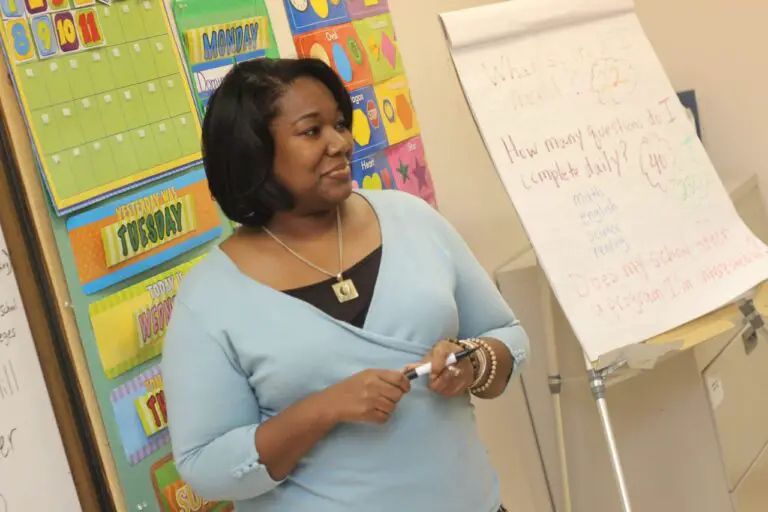Sport is a huge part of our lives, whether we enjoy playing team games, getting some exercise, or just watching it on TV. And there’s no doubt about the fact it’s one of the most common EFL/ESL topics.

So we want to make sure our classes on sport are fantastic. Instead of using boring worksheets and basic flashcards, use these five activities to get your students active and enjoying their learning.
Of course not all the activities will be appropriate for your class straight away, but with some thought and adaptation, you can certainly use most of them.
So let’s not mess about any more and kick off with the activities!
- Sports Gear Show & Tell
- What Are They Doing? / What Were They Doing?
- Commentary Challenge
- Role Plays
- Word Basketball (or bowling)
1. Sports Gear Show & Tell
Almost all students you teach will do sport or exercise of some kind. And if they don’t, they’ll know someone who does. So rather than learning about it in a textbook, why not get students to share the sports they do?
A great way of doing this is with Show & Tell. Each student brings in an item (or items) related to a sport they do, for example a tennis racket, a snorkelling mask or a gumshield. They show it to the class and share their experiences with the sport.
There are two ways you can approach this.
- First, make it into a more formal presentation with students giving a short speech while the others (or just you if it’s an individual class) listen. This is best for students who struggle to speak conversationally and need more structure.
- Second, turn it into more of a question and answer session. You and the other students ask questions about the item they brought and the sport they practice. This is best for students who are chatty and feel confident asking and answering questions.
This activity works great with kids, but there’s no reason why you can’t use it with adults either. Draw from their varied sporting activities while they learn language that is personally relevant and useful.
2. What Are They Doing? / What Were They Doing?
This is a fun game that practices vocabulary as well as the present continuous (or past continuous).
It lends itself particularly well to practicing the names of sports, but you can use it with other language categories, too.

How to play
Select 3-4 students to stand at the front and be the actors. The rest are guessers. If you have a small class, you need at least one guesser, and the rest actors.
Guessers close their eyes while the actors silently mime a sport e.g. swimming, martial arts or basketball.
After a few seconds, shout “STOP!” at the actors, who must freeze in their current position. Now, guessers can look. They should try to guess what the actors are doing (or were doing) using the present continuous (or past continuous).
For example, “Ken is playing basketball.”
or “Ana was doing martial arts.”After all the actions have been guessed, choose a different set of actors and repeat.
Take part as an actor to introduce new sports. Encourage students to team up to do a sport together, for example, playing table tennis.
You can also hone in on the verbs related to each sport: play, go, do, etc.
3. Commentary Challenge
Commentary Challenge is not for beginners. It’s a speaking activity that requires quick thinking and improvisation. Intermediates who are confident speakers will do okay, but those who struggle with fluency may find it difficult to begin with. But they’ll get better by taking part!

Before the class, find some sporting videos. This could be clips of a football match, footage of an olympic event, or a record-breaking attempt.
Events like high jump or javelin are good because you can get one student to commentate on each individual attempt, with time to pause in between. For extended speaking practice, free-flowing games like football are more appropriate.
I recommend choosing a sport that is familiar to students, listening to some example commentary beforehand and brainstorming some of the most useful language for students to refer to while they speak.
Then challenge students to provide running commentary. This can be a bit stressful for some, especially in front of a large class, but many students will love the opportunity to speak freely.
4. Role Plays
Role plays are always a great way to make English interesting. They encourage spontaneous dialogue and build fluency rapidly. However, they’re not suitable for absolute beginners who can’t yet construct sentences, and young children (under 8) will struggle with most scenarios.

Role plays don’t have scripts. They are the enactment of an imaginary situation in which each student takes on a role and behaves accordingly.
To learn more about why I love role play so much, read my article Why All EFL/ESL Teachers Should Use Role Play Activities.
They’re best done in pairs. If you have an individual student, take part with them. With an odd number of students, you can make a group of 3 and use the third, optional role (C).
Here’s a scenario you can use right now!
In pairs, just assign the roles A and B. For groups of three, add in role C as a supplementary character.
Olympic Interview
| STUDENT | ROLE |
|---|---|
| A | You just won an Olympic gold medal and now you are having an interview about your victory! |
| B | You are a reporter for a newspaper. You ask questions to the new Olympic gold medallist (student A) about their victory. |
| C (optional) | You are a reporter for a TV news station. You ask questions to the new Olympic gold medallist (student A) about their victory. |
5. Word Basketball (or bowling)
An EFL/ESL teacher’s favourite, Word Basketball is always good fun. In this case we’ll play with sports vocabulary, but really you can do it with any category.
The base game is very simple, but there are lots of variations you can implement.
How to play
Set up a basketball “net”. This can be a bucket, empty bin or cardboard box. You also need a ball. This could be a real ball or a scrunched up piece of paper. As long as it’s easy to throw, it’ll do.
In turn, players take shots at the “net” from behind a line on the floor (take a few practice shots from different distances to find out where is an appropriate challenge). Before throwing, they have to say a sport. Then they throw the ball and if it lands in the “net”, they get a point.
If you have a large class, split them into 2-3 teams, with students earning points for their respective team.
Play as many rounds as time allows. At the end, the player/team with the most points wins.
VARIATION 1: Flashcards Ladder
Lay out three flashcards (pictures, not words) on the floor each getting closer to the net. If possible, make the furthest flashcard from the net an easy one and the closest a difficult.
Students start at the furthest, but if they can say what the sport is on the flashcard, they can step forward, to the next flashcard. If they can’t say the name of the sport, they have to throw the ball from where they are.

VARIATION 2: Difficulty Points
When students offer a word, award them a potential number of points based on the difficulty of the word. For example, football is easy, so they will get 1 point if they get the ball in the net. Sailing is more challenging – 2 points. Rappeling is even harder, so they’d get 3 points.
I like to allow players (and teams) to use resources in the classroom to find new words while it’s not their turn. This way they actively find new vocabulary.
This is my favourite way to play this game, although it can be tricky to know how many points to award each word, so be prepared for some students to disagree!
A sub-variation of this game is instead of awarding more potential points for a difficult word, give the student 2 or 3 attempts to get the ball in the net.
VARIATION 3: Bowling (or another sport)
Instead of throwing a ball into a net, why not have them do some bowling and try to knock down some pins? What about darts?
Think of the resources you have available and what sports you could adapt for the classroom. I’ve even played the game with a real basketball and net, as well as a football (soccer) penalty variation in after-school classes.
Its the taking part that counts
Sports are, by their very nature, competitive and active. But competition isn’t ideal for most EFL/ESL classrooms, so make sure students who don’t like fighting for victory, or who don’t like sports, feel included and engaged with the activities.
The trick is to know your students and adapt to suit their needs. So pick which ideas above sounded best and make them your own!
For more activities, games, role-play scenarios and lesson plans, sign up to the Enchanted ESL Newsletter. Every month I send out a whole bunch of free resources, and that’s on top of the ones you get as soon as you join. Follow this link to the signup page now!









